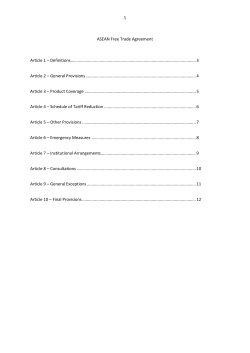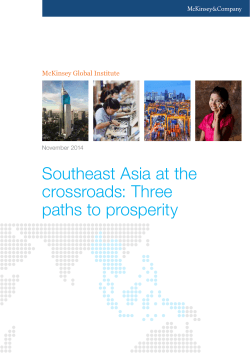
Hakuhodo Institute of Life and Living ASEAN (HILL ASEAN) Sei-katsu-sha
9 October, 2014 Hakuhodo Institute of Life and Living ASEAN (HILL ASEAN) Hosts First ‘ASEAN Sei-katsu-sha Forum’ in Bangkok Latest research finds ‘The Connected Family: The New ASEAN Family’ (Bangkok, 9 October, 2014) – Hakuhodo Institute of Life and Living ASEAN (“HILL ASEAN”), a think tank established in 2014 in Thailand by Japan’s second largest advertising company, Hakuhodo Inc., announced findings from latest research into “The New ASEAN Family” at its first ASEAN Sei-katsu-sha Forum 2014 in Bangkok on October 9. It was attended by over 200 marketing staffers and managers from ASEAN, Thai and Japanese companies as well as Thai media. Hakuhodo President & CEO Hirokazu Toda introduced the forum explaining the group’s fundamental ‘sei-katsu-sha 1 ’ philosophy in support of marketing in ASEAN countries – which involves understanding and appealing to lifestyles of people, not just treating them as “consumers”. In summary, this latest research found a “new type of family is emerging in the ASEAN region”. As elsewhere in developed and developing countries, nuclear families have become more commonplace throughout ASEAN – driven by economic growth and urbanization. “But we believe that rather than diffusion and division of families seen in Japan and other developed countries, ASEAN families are taking their own distinctive course,” concluded the report. “ASEAN families still yearn to achieve happiness as an extended family unit, despite the spread of the nuclear family.” 1 Sei-katsu-sha are more than simply consumers, just as people’s lives and lifestyles include more than just shopping. Hakuhodo introduced this term in the 1980s to emphasize its commitment to a comprehensive, 360-degree perspective on consumers’ lives. Smart technology is the key link – to the extent that being connected to social media links like Facebook and Twitter is a major lifestyle priority for many. “The house may have no air conditioning, no running water, or be missing a wall, but everyone in the family owns a smart phone,” the report noted. “They’re more interested in human interaction than improved housing. Relatives living in the countryside are getting smart phones too, so that they can stay in touch with their family members in the city.” Surprisingly, the research indicated “this situation has not been noticed in other parts of the world”. It suggested the emergence of “a new type of ASEAN family” – an extended family that on the surface appears to have split into several nuclear families, but whose members “actually share bonds that are closer than ever”. HILL ASEAN has created a new term for this “invisible extended family unit that on the surface appears to be divided” – the Connected Family. Research across the ASEAN countries revealed a common picture of this Connected Family “which is neither an extended nor a nuclear family, but seeks happiness as an extended family unit”. HILL ASEAN notes that extended families interacting both online and in the real world despite living in separate households are often “overlooked by censuses and standard surveys focusing on the household, since they do not live under the same roof.” From a marketing perspective, also overlooked is that “anyone in that family can become an “influencer” sharing information and contributing to the clan’s wellbeing” in whatever field they know best, whether IT, food, travel or any other product. And unlike before, when family elders tended to take control of all matters, today, “anyone in the family can become an influencer sharing information”, depending on the topic of interest, regardless of age, sex, or status. What this means to marketers and companies is acknowledging, appreciating and understanding the importance of the ‘connected family’ as a “connecting platform disseminating the message more effectively than conventional approaches”. The latest research findings are based on Hakuhodo’s original survey and database ASEAN Fixed Point Survey (see Note 1); ASEAN Home Visit Survey (see Note 2), which uses family mapping; and demographic and other data study, which look at ASEAN sei-katsu-sha using quantitative and qualitative approaches. It monitored changing attitudes, values and lifestyles in six ASEAN cities – Bangkok, Jakarta, Singapore, Ho Chi Minh City, Kuala Lumpur and Manila. HILLASEAN will continue its research, observing sei-katsu-sha from its unique viewpoints and making proposals from insights gained from these fresh perspectives. -------------------------ENDS------------------------Note 1 ASEAN Fixed Point Survey: Undertaken every other year, this Hakuhodo original survey looks at sei-katsu-sha’s lives from a 360° perspective, enabling the tracing of changing patterns over time. Survey outline Cities surveyed: Bangkok, Ho Chi Minh City, Jakarta, Kuala Lumpur, Manila, Singapore Sample size: 5,400 (900 samples per city) Survey subjects: Aged 15–59, SEC classes A–D, distributed by percentage of population No. of questions: 1,003 Survey method: Subjects interviewed in their homes Period of study: December 2013–January 2014 Note 2 ASEAN Home-Visit Survey: A survey using family mapping that is designed to assess the state of the family in ASEAN countries in preparation for ASEAN Sei-katsu-sha Forum 2014. Survey outline Cities surveyed: Bangkok, Ho Chi Minh City, Jakarta, Kuala Lumpur, Manila, Singapore Survey subjects: 3 nuclear families and 1 extended family (each with at least 1 smartphone) in each country Survey method: Ethnographic home visits, family mapping Period of study: May 2014 Research: Tokyo Survey Research & Co., Ltd., Cimigo Holdings Ltd. About Hakuhodo Institute of Life and Living ASEAN Established in 2014, Hakuhodo Institute of Life and Living ASEAN is the Hakuhodo Group’s new sei-katsu-sha think tank in the ASEAN region. Leveraging sei-katsu-sha research know-how accumulated in the thirty-odd years since launching the Hakuhodo Institute of Life and Living in Japan in 1981, the Institute supports companies’ marketing activities in the ASEAN region, while developing local insights and making proposals on future ways of living in the region. Name in English: Hakuhodo Institute of Life and Living ASEAN Institute Director: Goro Hokari (Hakuhodo Asia Pacific Co., Ltd.) Location: Bangkok, Thailand (within Hakuhodo Asia Pacific) Research & other activities: ASEAN Fixed Point Survey, a fixed-point survey of ASEAN sei-katsu-sha (once every two years) Research and analysis from local ASEAN perspectives in countries Forums in ASEAN countries Visioning of ASEAN sei-katsu-sha futures based on Fixed Point Survey data About Hakuhodo Founded in 1895, Hakuhodo Inc. is an integrated advertising and communication agency headquartered in Japan. It is the core agency of Hakuhodo DY Group, the world’s seventh largest agency company according to Advertising Age’s “Agency Report 2014.” Hakuhodo has offices in 17 countries and regions, and over 3,000 employees working in Japan and over 2,500 overseas. Hakuhodo is strengthening its structure in emerging countries, particularly those in Asia, as it prepares to further expand its business across the region. Sei-katsu-sha insight is the foundation for Hakuhodo’s thinking, planning, and brand building. It reminds us that consumers are more than shoppers performing an economic function. They have heartbeats. They are individuals with distinct lifestyles. Hakuhodo introduced this term in the 1980s to emphasize its commitment to a comprehensive, 360-degree perspective on consumers’ lives. Renowned for its creativity, Hakuhodo is the agency headquartered in Asia to have twice won the Grand Prix at Cannes Lions International Festival of Creativity. To learn more, visit: www.hakuhodo.jp Media contacts: Corporate Public Relations Division Ken Odaka: ken.odaka@hakuhodo.co.jp Tel: +81-(0)3-6441-6161 Fax: +81-(0)3-6441-6166 Reference: Commonalities between ASEAN countries ASEAN Fixed Point Survey 2014 contained about a thousand items, and all six ASEAN countries scored significantly higher than Japan on two of them in particular: “My future is bright” and “My world is full of hopes and dreams.” Needless to say, one factor behind the optimism is the region’s economic growth as exemplified by nominal per capita GDP, which has grown significantly in each country over the past decade. An unchanged traditional ASEAN family Devotion to family, often cited as a characteristic of the whole ASEAN region, clearly revealed itself in our research. All six ASEAN countries scored higher than Japan on family-related items such as “Satisfied with family relations” and “Want to spend more time with family.” Despite splitting into nuclear families, people obviously still cherish family relationships. A changing milieu in the region Comparing the ownership of digital devices in ASEAN’s major cities with Japan, smartphone ownership is roughly the same, while tablets ownership is actually higher in the ASEAN countries. While the spread of information technology took place gradually in Japan as the economy shifted for stable growth to maturity, the ASEAN region seems to have skipped straight to smart devices, right in the middle of high economic growth. A unique course of evolution for ASEAN sei-katsu-sha In Japan and the rest of the developed world, extended families split into nuclear families as a result of urbanization, and a division arose between urban and rural areas. Family members became separated. As the economy grew, individuals improved their financial status by living in smaller households. But in the process, single-person households replaced the nuclear family as the most common household type, leading to such societal problems as people becoming socially isolated and dying alone. In ASEAN countries, on the other hand, the traditional sense of family is so strong that, despite the spread of the nuclear household, people still yearn to achieve happiness as an extended family unit. Moreover, simultaneous urbanization and adoption of smart technology has enhanced people’s desire for human interaction. At first glance, it may appear that the extended family has split into multiple nuclear families, but in reality, these two desires have strengthened family solidarity. In their quest for happiness ASEAN sei-katsu-sha operate within neither the nuclear family nor the confines of the extended family, but rather as a familial team. The new ASEAN family: The Connected Family Urbanization in ASEAN countries has split extended families and increased the prevalence of nuclear families. ASEAN sei-katsu-sha have not, however, become insulated within their household units. Instead, they have preserved their strong bonds using smart technology. We have created a new term for this type of family: The Connected Family. Characteristic 1: An extended family that looks like a nuclear family on the surface Extended families whose members interact both online and in the real world despite living iving in separate households are overlooked by censuses and standard surveys focusing on the household since they do not live under the same roof. They may be considered a new unit alongside the individual and the household. Characteristic 2: Acts as a safety sa net while preserving privacy The extended ASEAN family continues to fulfill the mutual aid and safety net functions that are among the advantages of a big family, while ameliorating the lack of privacy that is its disadvantage, because everyone lives in their own home. Characteristic 3: Anyone in the family can become an “influencer” Unlike in previous years when the elders of the family took control of all matters, today, anyone in the family can become an influencer sharing information or a family leader contributing to the clan’s wellbeing in whatever field they know best, whether IT, food or travel. Characteristic 4: Makes full use of the three must-have tools for uniting the family 1. Social media for storing family memories Families set up their own family groups of up to 100 members on Facebook and even store nostalgic black-and-white family photos there. 2. Chat app, the family bulletin board Families create groups of around 50 people on Line, and use it to share everything from jokes to suras from the Koran. 3. Video calls for bonding with family members (“fam-to-fam” bonding) People make video calls to home every day in order to bond with faraway parents, or a child they’ve left with them to look after.
© Copyright 2025














